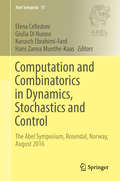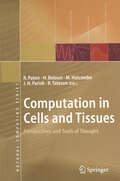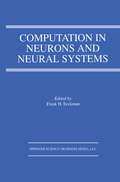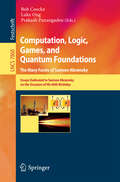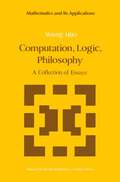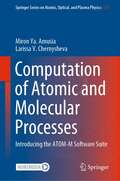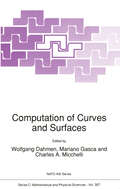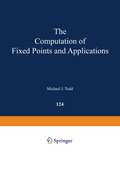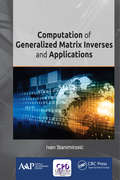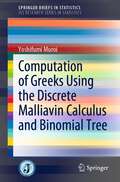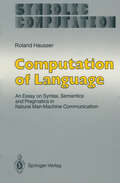- Table View
- List View
Computation and Approximation (SpringerBriefs in Mathematics)
by Vijay Gupta Michael Th. RassiasThis brief studies recent work conducted on certain exponential type operators and other integral type operators. It consists of three chapters: the first on exponential type operators, the second a study of some modifications of linear positive operators, and the third on difference estimates between two operators. It will be of interest to students both graduate and undergraduate studying linear positive operators and the area of approximation theory.
Computation and Asymptotics (SpringerBriefs in Applied Sciences and Technology)
by Rudrapatna V. RamnathThis book addresses the task of computation from the standpoint of asymptotic analysis and multiple scales that may be inherent in the system dynamics being studied. This is in contrast to the usual methods of numerical analysis and computation. The technical literature is replete with numerical methods such as Runge-Kutta approach and its variations, finite element methods, and so on. However, not much attention has been given to asymptotic methods for computation, although such approaches have been widely applied with great success in the analysis of dynamic systems. The presence of different scales in a dynamic phenomenon enable us to make judicious use of them in developing computational approaches which are highly efficient. Many such applications have been developed in such areas as astrodynamics, fluid mechanics and so on. This book presents a novel approach to make use of the different time constants inherent in the system to develop rapid computational methods. First, the fundamental notions of asymptotic analysis are presented with classical examples. Next, the novel systematic and rigorous approaches of system decomposition and reduced order models are presented. Next, the technique of multiple scales is discussed. Finally application to rapid computation of several aerospace systems is discussed, demonstrating the high efficiency of such methods.
Computation and Combinatorics in Dynamics, Stochastics and Control: The Abel Symposium, Rosendal, Norway, August 2016 (Abel Symposia #13)
by Elena Celledoni Giulia Di Nunno Kurusch Ebrahimi-Fard Hans Zanna Munthe-KaasThe Abel Symposia volume at hand contains a collection of high-quality articles written by the world’s leading experts, and addressing all mathematicians interested in advances in deterministic and stochastic dynamical systems, numerical analysis, and control theory. In recent years we have witnessed a remarkable convergence between individual mathematical disciplines that approach deterministic and stochastic dynamical systems from mathematical analysis, computational mathematics and control theoretical perspectives. Breakthrough developments in these fields now provide a common mathematical framework for attacking many different problems related to differential geometry, analysis and algorithms for stochastic and deterministic dynamics. In the Abel Symposium 2016, which took place from August 16-19 in Rosendal near Bergen, leading researchers in the fields of deterministic and stochastic differential equations, control theory, numerical analysis, algebra and random processes presented and discussed the current state of the art in these diverse fields. The current Abel Symposia volume may serve as a point of departure for exploring these related but diverse fields of research, as well as an indicator of important current and future developments in modern mathematics.
Computation and Comparison of Efficient Turbulence Models for Aeronautics — European Research Project ETMA (Notes on Numerical Fluid Mechanics #5)
by Alain Dervieux Marianna Braza Jean-Paul DussaugeThis volume contains contributions to the BRITE-EURAM 3rd Framework Programme ETMA and extended articles of the TMA-Workshop. It focusses on turbulence modelling techniques suitable to use in typical flow configurations, with emphasis on compressibility effects and inherent unsteadiness. These methodologies are applied to the Navier-Stokes equations, involving various turbulence modelling levels from algebraic to RSM. Basic turbulent flows in aeronautics are considered; mixing layers, wall-flows (flat-plate, backward-facing step, ramp, bump), and more complex configurations (bump, aerofoil). A critical assessment of the turbulence modelling performances is offered, based on previous results and on the experimental data-base of this research programme. The ETMA results figure in the data-base constituted by all partners and organized by INRIA
Computation and Control: Proceedings of the Bozeman Conference, Bozeman, Montana, August 1–11, 1988 (Progress in Systems and Control Theory #1)
by Kenneth L. Bowers John LundThe problem of developing a systematic approach to the design of feed back strategies capable of shaping the response of complicated dynamical control systems illustrates the integration of a wide variety of mathemat ical disciplines typical of the modern theory of systems and control. As a concrete example, one may consider the control of fluid flow across an airfoil, for which recent experiments indicate the possibility of delaying the onset of turbulence by controlling viscosity through thermal actuators located on the airfoil. In general, there are two approaches to the con trol of such a complica. ted process, the development of extremely detailed models of the process followed by the derivation of a more "dedicated" feed back law or the development of a more simple model class followed by the derivation of control laws which are more robust to unmodelled dynamics and exogeneous disturbances. In either approach, the two twin themes of approximation and computation play a significant role in the derivation and implementation of resulting control laws. And there is no doubt that the cross-fertilization between these twin themes and control theory will increase unabated throughout the next decade, not just as an important component of design and implementation of control laws but also as a source of new problems in computational mathematics. In this volume, we present a collection of papers which were deliv ered at the first Bozeman Conference on Computation and Control, held at Montana State University on August 1-11, 1988.
Computation and Control IV: Proceedings of the Fourth Bozeman Conference, Bozeman, Montana, August 3–9, 1994 (Progress in Systems and Control Theory #20)
by Kenneth L. Bowers John LundProceedings of a conference of leading experts in control theory, numerical mathematics and various application areas. The conference’s interdisciplinary dialogue not only creates new mathematical tools, it often produces new research problems in the individual disciplines, aiming to develop rigorous numerical methods and computational tools for control design and analysis.
Computation and Neural Systems
by Frank Eeckman James M. BowerComputational neuroscience is best defined by its focus on understanding the nervous systems as a computational device rather than by a particular experimental technique. Accordinlgy, while the majority of the papers in this book describe analysis and modeling efforts, other papers describe the results of new biological experiments explicitly placed in the context of computational issues. The distribution of subjects in Computation and Neural Systems reflects the current state of the field. In addition to the scientific results presented here, numerous papers also describe the ongoing technical developments that are critical for the continued growth of computational neuroscience. Computation and Neural Systems includes papers presented at the First Annual Computation and Neural Systems meeting held in San Francisco, CA, July 26--29, 1992.
Computation, Cooperation, and Life: Essays Dedicated to Gheorghe Paun on the Occasion of His 60th Birthday (Lecture Notes in Computer Science #6610)
by Jozef Kelemen Alica KelemenováGheorghe Păun has played an important role within a wide range of disciplines, from the foundations of traditional computation theory and formal language theory to research gaining its inspiration from living nature. He has significantly contributed to the development of these diverse fields, initiating and pioneering some of them with remarkable imaginativeness and enthusiasm. Gheorghe Păun’s research focusses on systems inspired by structures and processes found in living systems, with the field of membrane computing or P systems being the most important of his initiatives. This Festschrift volume, published to honor Gheorghe Păun on the occasion of his 60th birthday, includes 16 contributions by his students and collaborators. The research presented aims to gain a better understanding of what computation is, to find better models of computation, and to look for new computing devices inspired by the structure and/or functioning of natural or societal systems. The papers are preceded by an introduction by Solomon Marcus, Gheorghe Păun’s lifelong teacher and mentor, and are organized in topical sections on general computing, grammar systems, membrane systems, and inspirations from natural computing.
Computation, Cryptography, and Network Security
by Nicholas J. Daras Michael Th. RassiasAnalysis, assessment, and data management are core competencies for operation research analysts. This volume addresses a number of issues and developed methods for improving those skills. It is an outgrowth of a conference held in April 2013 at the Hellenic Military Academy, and brings together a broad variety of mathematical methods and theories with several applications. It discusses directions and pursuits of scientists that pertain to engineering sciences. It is also presents the theoretical background required for algorithms and techniques applied to a large variety of concrete problems. A number of open questions as well as new future areas are also highlighted.This book will appeal to operations research analysts, engineers, community decision makers, academics, the military community, practitioners sharing the current “state-of-the-art,” and analysts from coalition partners. Topics covered include Operations Research, Games and Control Theory, Computational Number Theory and Information Security, Scientific Computing and Applications, Statistical Modeling and Applications, Systems of Monitoring and Spatial Analysis.
Computation Engineering: Applied Automata Theory and Logic
by Ganesh GopalakrishnanAlthough it is critical in today’s world that students who take automata theory and logic courses retain what they have learned and understand how to use their knowledge, many textbooks typically emphasize automata theory only, not logic, thus losing a valuable opportunity to tie these subjects together and reinforce learning. This textbook uses interactive tools throughout, such as simple BDD and SAT tools. By providing a blend of theory and practical applications the material is presented as both inviting and current. Key concepts are illustrated in multiple domains so that information is reinforced and students can begin to tie theory and logic together.
Computation for Humanity: Information Technology to Advance Society (Computational Analysis, Synthesis, and Design of Dynamic Systems)
by Justyna Zander and Pieter J. MostermanThe exponential progress and accessibility of computing has vastly increased data flows and revolutionized the practice of science, engineering, and communication. Computing plays a critical role in advancing research across almost every scientific discipline. Computation for Humanity: Information Technology to Advance Society is a guide for the creation of services, products, and tools that facilitate, support, and enhance progress of humanity toward more sustainable life. This book: Provides a deep understanding of the practical applications of computation to solve human-machine problems Delivers insight into theoretical approaches in an accessible manner Provides a comprehensive overview of computational science and engineering applications in selected disciplines Crosses the boundaries between different domains and shows how they interrelate and complement one another Focuses on grand challenges and issues that matter for the future of humanity Shows different perspectives of computational thinking, understanding, and reasoning Provides a basis for scientific discoveries and enables adopting scientific theories and engineering practices from other disciplines Takes a step back to provide a human-related abstraction level that is not ultimately seen in pure technological elaborations/collections The editors provide a collection of numerous computation-related projects that form a foundation from which to cross-pollinate between different disciplines and further extensive collaboration. They present a clear and profound understanding of computing in today's world, and provide fundamental solutions to some of the most pertinent humanity-related problems.
Computation for Humanity: Information Technology to Advance Society (Computational Analysis, Synthesis, and Design of Dynamic Systems)
by Justyna Zander Pieter J. MostermanThe exponential progress and accessibility of computing has vastly increased data flows and revolutionized the practice of science, engineering, and communication. Computing plays a critical role in advancing research across almost every scientific discipline. Computation for Humanity: Information Technology to Advance Society is a guide for the creation of services, products, and tools that facilitate, support, and enhance progress of humanity toward more sustainable life. This book: Provides a deep understanding of the practical applications of computation to solve human-machine problems Delivers insight into theoretical approaches in an accessible manner Provides a comprehensive overview of computational science and engineering applications in selected disciplines Crosses the boundaries between different domains and shows how they interrelate and complement one another Focuses on grand challenges and issues that matter for the future of humanity Shows different perspectives of computational thinking, understanding, and reasoning Provides a basis for scientific discoveries and enables adopting scientific theories and engineering practices from other disciplines Takes a step back to provide a human-related abstraction level that is not ultimately seen in pure technological elaborations/collections The editors provide a collection of numerous computation-related projects that form a foundation from which to cross-pollinate between different disciplines and further extensive collaboration. They present a clear and profound understanding of computing in today's world, and provide fundamental solutions to some of the most pertinent humanity-related problems.
Computation for Metaphors, Analogy, and Agents (Lecture Notes in Computer Science #1562)
by Chrystopher L. NehanivThis volume brings together the work of researchers from various disciplines where aspects of descriptive, mathematical, computational or design knowledge concerning metaphor and analogy, especially in the context of agents, have emerged. The book originates from an international workshop on Computation for Metaphors, Analogy, and Agents (CMAA), held in Aizu, Japan in April 1998.The 19 carefully reviewed and revised papers presented together with an introduction by the volume editor are organized into sections on Metaphor and Blending, Embodiment, Interaction, Imitation, Situated Mapping in Space and Time, Algebraic Engineering: Respecting Structure, and a Sea-Change in Viewpoints.
Computation for the Analysis of Designed Experiments (Wiley Series in Probability and Statistics #194)
by Richard HeibergerAddresses the statistical, mathematical, and computational aspects of the construction of packages and analysis of variance (ANOVA) programs. Includes a disk at the back of the book that contains all program codes in four languages, APL, BASIC, C, and FORTRAN. Presents illustrations of the dual space geometry for all designs, including confounded designs.
Computation in Cells and Tissues: Perspectives and Tools of Thought (Natural Computing Series)
by R. Paton Hamid Bolouri W. Michael L. Holcombe J. Howard Parish Richard TatesonThe field of biologically inspired computation has coexisted with mainstream computing since the 1930s, and the pioneers in this area include Warren McCulloch, Walter Pitts, Robert Rosen, Otto Schmitt, Alan Turing, John von Neumann and Norbert Wiener. Ideas arising out of studies of biology have permeated algorithmics, automata theory, artificial intelligence, graphics, information systems and software design. Within this context, the biomolecular, cellular and tissue levels of biological organisation have had a considerable inspirational impact on the development of computational ideas. Such innovations include neural computing, systolic arrays, genetic and immune algorithms, cellular automata, artificial tissues, DNA computing and protein memories. With the rapid growth in biological knowledge there remains a vast source of ideas yet to be tapped. This includes developments associated with biomolecular, genomic, enzymic, metabolic, signalling and developmental systems and the various impacts on distributed, adaptive, hybrid and emergent computation. This multidisciplinary book brings together a collection of chapters by biologists, computer scientists, engineers and mathematicians who were drawn together to examine the ways in which the interdisciplinary displacement of concepts and ideas could develop new insights into emerging computing paradigms. Funded by the UK Engineering and Physical Sciences Research Council (EPSRC), the CytoCom Network formally met on five occasions to examine and discuss common issues in biology and computing that could be exploited to develop emerging models of computation.
Computation in Neurons and Neural Systems
by Frank EeckmanComputation in Neurons and Neural Systems contains the collected papers of the 1993 Conference on Computation and Neural Systems which was held between July 31--August 7, in Washington, DC. These papers represent a cross-section of the state-of-the-art research work in the field of computational neuroscience, and includes coverage of analysis and modeling work as well as results of new biological experimentation.
Computation, Logic, Games, and Quantum Foundations - The Many Facets of Samson Abramsky: Essays Dedicted to Samson Abramsky on the Occasion of His 60th Birthday (Lecture Notes in Computer Science #7860)
by Bob Coecke Luke Ong Prakash PanangadenThis Festschrift volume, published in honor of Samson Abramsky, contains contributions written by some of his colleagues, former students, and friends. In celebration of the 60th birthday of Samson Abramsky, a conference was held in Oxford, UK, during May 28-30, 2010. The papers in this volume represent his manifold contributions to semantics, logic, games, and quantum mechanics.
Computation, Logic, Philosophy: A Collection of Essays (Mathematics and its Applications #2)
by Wang HaoComputation of Atomic and Molecular Processes: Introducing the ATOM-M Software Suite (Springer Series on Atomic, Optical, and Plasma Physics #117)
by Miron Ya. Amusia Larissa V. ChernyshevaThis book presents numerical methods for solving a wide range of problems associated with the structure of atoms and simplest molecules, and their interaction with electromagnetic radiation, electrons, and other particles. It introduces the ATOM-M software package, presenting a unified software suite, written in Fortran, for carrying out precise atomic and molecular numeric calculations. The book shows how to apply these numerical methods to obtain many different characteristics of atoms, molecules, and the various processes within which they interact. In an entirely self-sufficient approach, it teaches the reader how to use the codes provided to build atomic and molecular systems from the ground up and obtain the resulting one-electron wave functions. The computational programs presented and made available in this book allow calculations in the one-electron Hartree–Fock approximation and take into account many-electron correlations within the framework of the random-phase approximation with exchange or many-body perturbation theory. Ideal for scholars interested in numerical computation of atomic and molecular processes, the material presented in this book is useful to both experts and novices, theorists, and experimentalists.
Computation of Curves and Surfaces (Nato Science Series C: #307)
by Wolfgang Dahmen Mariano Gasca Charles A. MicchelliAssembled here is a collection of articles presented at a NATO ADVANCED STU DY INSTITUTE held at Puerto de la Cruz, Tenerife, Spain during the period of July 10th to 21st, 1989. In addition to the editors of these proceedings Professor Larry L. Schumaker from Vanderbilt University, Nashville, Tennessee, served as a member of the international organizing committee. The contents of the contribu tions fall within the heading of COMPUTATION OF CURVES AND SURFACES and therefore address mathematical and computational issues pertaining to the dis play, modeling, interrogation and representation of complex geometrical objects in various scientific and technical environments. As is the intent of the NATO ASI program the meeting was two weeks in length and the body of the scientific activities was organized around prominent experts. Each of them presented lectures on his current research activity. We were fortunate to have sixteen distinguished invited speakers representing nine NATO countries: W. Bohm (Federal Republic of Germany), C. de Boor (USA), C.K. Chui (USA), W. Dahmen (Federal Republic of Germany), F. Fontanella (Italy), M. Gasca (Spain), R. Goldman (Canada), T.N.T. Goodman (UK), J.A. Gregory (UK), C. Hoffman (USA), J. Hoschek (Federal Republic of Germany), A. Le Mehaute (France), T. Lyche (Norway), C.A. Micchelli (USA), 1.1. Schumaker (USA), C. Traas (The Netherlands). The audience consisted of both young researchers as well as established scientists from twelve NATO countries and several non-NATO countries.
The Computation of Fixed Points and Applications (Lecture Notes in Economics and Mathematical Systems #124)
by M. J. ToddFixed-point algorithms have diverse applications in economics, optimization, game theory and the numerical solution of boundary-value problems. Since Scarf's pioneering work [56,57] on obtaining approximate fixed points of continuous mappings, a great deal of research has been done in extending the applicability and improving the efficiency of fixed-point methods. Much of this work is available only in research papers, although Scarf's book [58] gives a remarkably clear exposition of the power of fixed-point methods. However, the algorithms described by Scarf have been super~eded by the more sophisticated restart and homotopy techniques of Merrill [~8,~9] and Eaves and Saigal [1~,16]. To understand the more efficient algorithms one must become familiar with the notions of triangulation and simplicial approxi- tion, whereas Scarf stresses the concept of primitive set. These notes are intended to introduce to a wider audience the most recent fixed-point methods and their applications. Our approach is therefore via triangu- tions. For this reason, Scarf is cited less in this manuscript than his contri- tions would otherwise warrant. We have also confined our treatment of applications to the computation of economic equilibria and the solution of optimization problems. Hansen and Koopmans [28] apply fixed-point methods to the computation of an invariant optimal capital stock in an economic growth model. Applications to game theory are discussed in Scarf [56,58], Shapley [59], and Garcia, Lemke and Luethi [24]. Allgower [1] and Jeppson [31] use fixed-point algorithms to find many solutions to boundary-value problems.
Computation of Generalized Matrix Inverses and Applications
by Ivan StanimirovićThis volume offers a gradual exposition to matrix theory as a subject of linear algebra. It presents both the theoretical results in generalized matrix inverses and the applications. The book is as self-contained as possible, assuming no prior knowledge of matrix theory and linear algebra. The book first addresses the basic definitions and concepts of an arbitrary generalized matrix inverse with special reference to the calculation of {i,j,...,k} inverse and the Moore–Penrose inverse. Then, the results of LDL* decomposition of the full rank polynomial matrix are introduced, along with numerical examples. Methods for calculating the Moore–Penrose’s inverse of rational matrix are presented, which are based on LDL* and QDR decompositions of the matrix. A method for calculating the A(2)T;S inverse using LDL* decomposition using methods is derived as well as the symbolic calculation of A(2)T;S inverses using QDR factorization. The text then offers several ways on how the introduced theoretical concepts can be applied in restoring blurred images and linear regression methods, along with the well-known application in linear systems. The book also explains how the computation of generalized inverses of matrices with constant values is performed. It covers several methods, such as methods based on full-rank factorization, Leverrier–Faddeev method, method of Zhukovski, and variations of the partitioning method.
Computation of Generalized Matrix Inverses and Applications
by Ivan StanimirovićThis volume offers a gradual exposition to matrix theory as a subject of linear algebra. It presents both the theoretical results in generalized matrix inverses and the applications. The book is as self-contained as possible, assuming no prior knowledge of matrix theory and linear algebra. The book first addresses the basic definitions and concepts of an arbitrary generalized matrix inverse with special reference to the calculation of {i,j,...,k} inverse and the Moore–Penrose inverse. Then, the results of LDL* decomposition of the full rank polynomial matrix are introduced, along with numerical examples. Methods for calculating the Moore–Penrose’s inverse of rational matrix are presented, which are based on LDL* and QDR decompositions of the matrix. A method for calculating the A(2)T;S inverse using LDL* decomposition using methods is derived as well as the symbolic calculation of A(2)T;S inverses using QDR factorization. The text then offers several ways on how the introduced theoretical concepts can be applied in restoring blurred images and linear regression methods, along with the well-known application in linear systems. The book also explains how the computation of generalized inverses of matrices with constant values is performed. It covers several methods, such as methods based on full-rank factorization, Leverrier–Faddeev method, method of Zhukovski, and variations of the partitioning method.
Computation of Greeks Using the Discrete Malliavin Calculus and Binomial Tree (SpringerBriefs in Statistics)
by Yoshifumi MuroiThis book presents new computation schemes for the sensitivity of options using the binomial tree and introduces readers to the discrete Malliavin calculus. It also shows that applications of the discrete Malliavin calculus approach to the binomial tree model offer fundamental tools for computing Greeks.The binomial tree approach is one of the most popular methods in option pricing. Although it is a fairly traditional model for option pricing, it is still widely used in financial institutions since it is tractable and easy to understand. However, the book shows that the tree approach also offers a powerful tool for deriving the Greeks for options. Greeks are quantities that represent the sensitivities of the price of derivative securities with respect to changes in the underlying asset price or parameters. The Malliavin calculus, the stochastic methods of variations, is one of the most popular tools used to derive Greeks. However, it is also very difficult to understand for most students and practitioners because it is based on complex mathematics. To help readers more easily understand the Malliavin calculus, the book introduces the discrete Malliavin calculus, a theory of the functional for the Bernoulli random walk. The discrete Malliavin calculus is significantly easier to understand, because the functional space of the Bernoulli random walk is realized in a finite dimensional space. As such, it makes this valuable tool far more accessible for a broad readership.
Computation of Language: An Essay on Syntax, Semantics and Pragmatics in Natural Man-Machine Communication (Symbolic Computation)
by Roland HausserThe study of linguistics has been forever changed by the advent of the computer. Not only does the machine permit the processing of enormous quantities of text thereby securing a better empirical foundation for conclusions-but also, since it is a modelling device, the machine allows the implementation of theories of grammar and other kinds of language processing. Models can have very unexpected properties both good and bad-and it is only through extensive tests that the value of a model can be properly assessed. The computer revolution has been going on for many years, and its importance for linguistics was recognized early on, but the more recent spread of personal workstations has made it a reality that can no longer be ignored by anyone in the subject. The present essay, in particular, could never have been written without the aid of the computer. I know personally from conversations and consultations with the author over many months how the book has changed. If he did not have at his command a powerful typesetting program, he would not have been able to see how his writing looked and exactly how it had to be revised and amplified. Even more significant for the evolution of the linguistic theory is the easy testing of examples made possible by the implementation of the parser and the computer-held lexicon. Indeed, the rule set and lexicon grew substantially after the successes of the early implementations created the desire to incorporate more linguistic phenomena.


